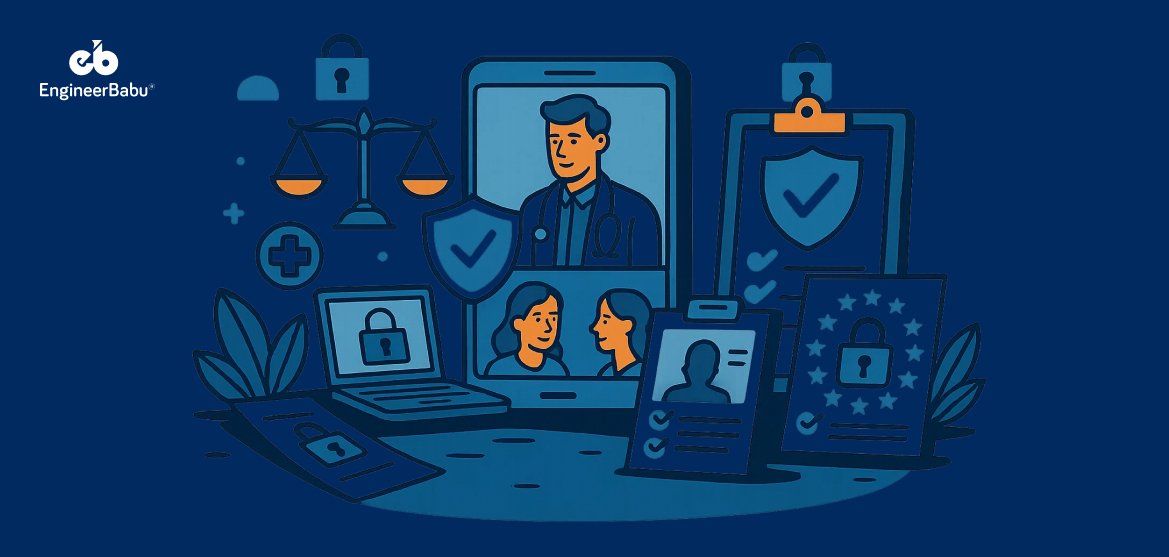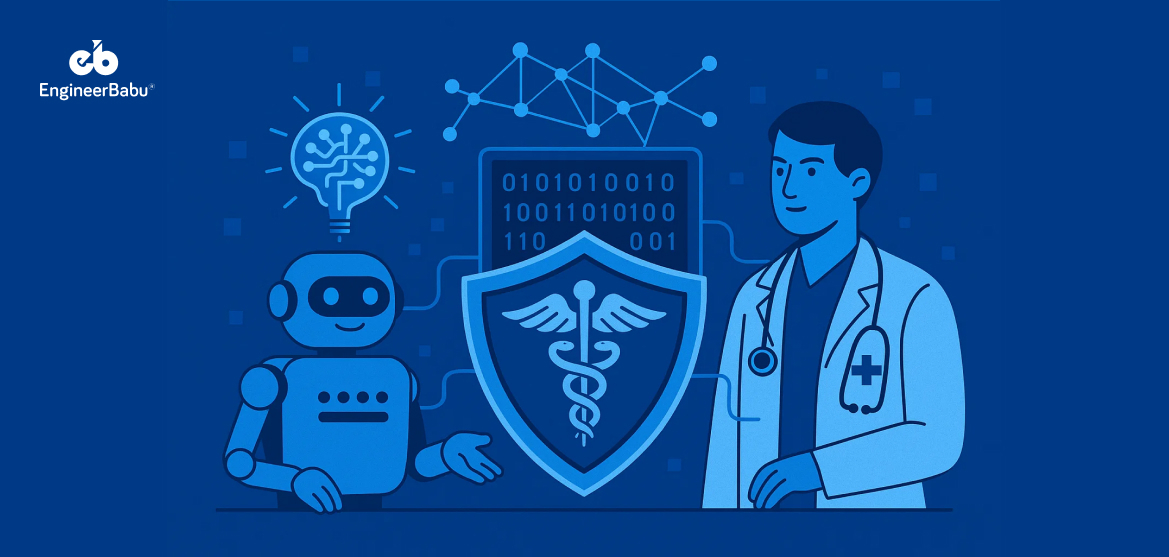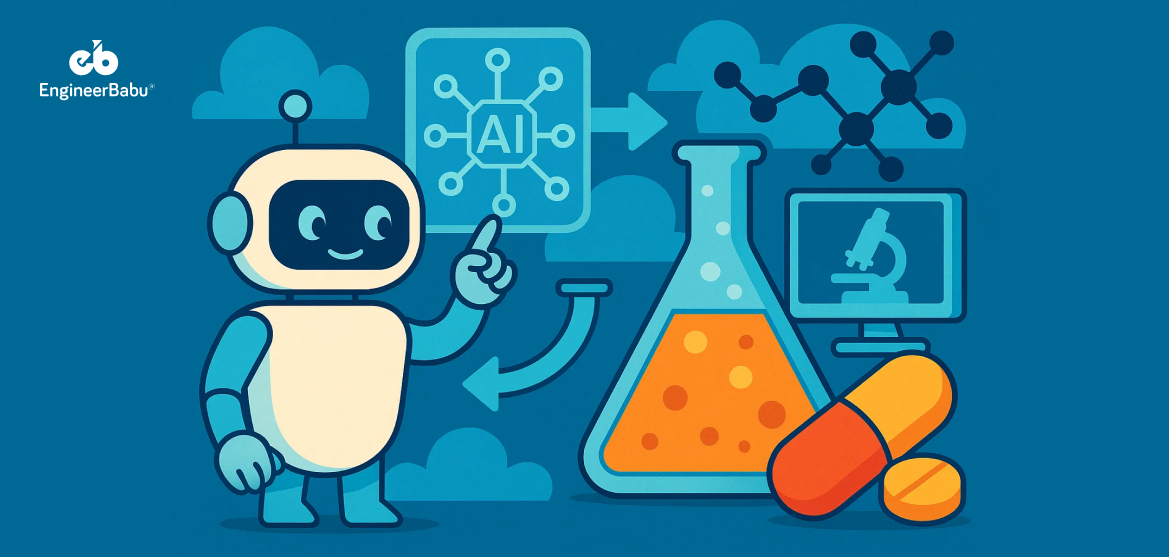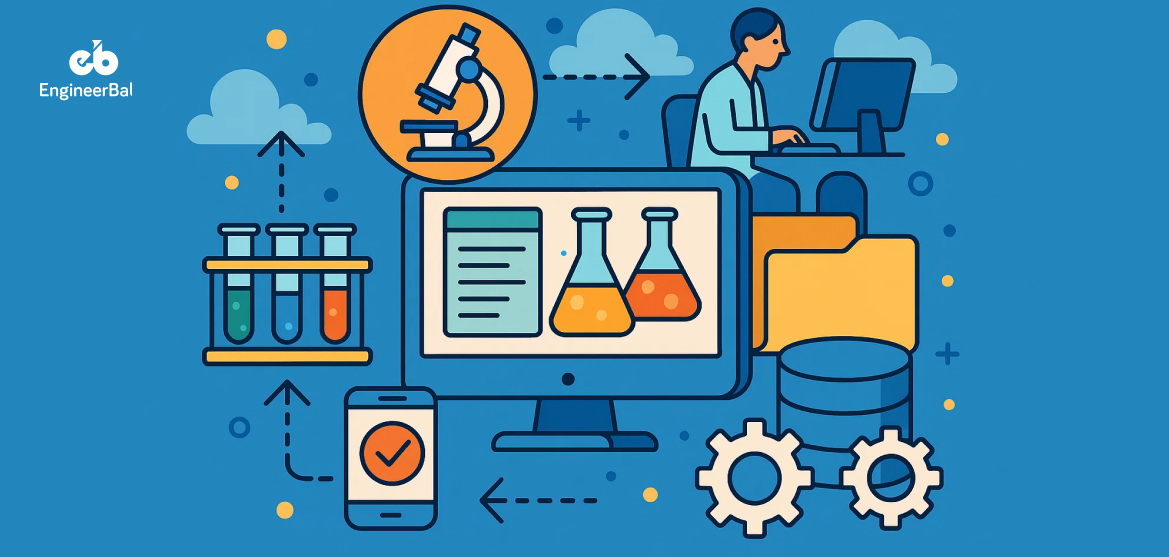Your telemedicine app might do everything from virtual consultations to e-prescriptions. But without proper telemedicine app compliance, it’s putting patient data and your business at serious risk.
With rising cybersecurity threats, compliance is now the foundation of trust between healthcare providers and patients.
Considering this, regulations now shape how apps handle data at every touchpoint. Here are two key facts that show how big the stakes are:
- HIPAA violations in the USA can lead to fines up to $1.5 million per year, as per American Medical Association.
- Moreover, GDPR violations can cost up to €20 million or 4% of a company’s global revenue.
Therefore, healthcare leaders now see compliance as part of patient care, not just legal protocol.
This blog breaks down the three pillars of telemedicine app compliance – HIPAA, HL7, and GDPR. You’ll learn what each means, why they matter, and how to build compliance into your product from the start.
Understanding Telemedicine App Compliance
Compliance in telemedicine means following laws that protect patient data during virtual care. It applies to every step of digital care. Telemedicine apps handle:
- Health records,
- Prescriptions,
- Billing information and
- Video call data.
Each type involves private details. Moreover, laws like HIPAA and GDPR treat this as sensitive data. They define how apps must collect, store, and share it.
For example, HIPAA protects patient identity and medical history. GDPR controls how data is used and who sees it. In short, these rules create the foundation of telemedicine app compliance. They help providers respect privacy and avoid legal risks.
Importance of Compliance for Healthcare Providers and Patients
Strong compliance does more than meet legal demands. It supports patient care and protects healthcare providers from costly mistakes. Here is why compliance is crucial for Healthcare providers and patients.
Protecting Sensitive Health Information
Healthcare data includes medical history, test results, mental health notes and billing records. Each of these is private. Telemedicine apps must protect this data. A breach can expose identities or reveal health conditions to the wrong people.
Furthermore, some attacks use stolen data for fraud or blackmail. Others damage a clinic’s reputation and cost them patients.
Telemedicine app compliance helps limit these risks. It gives providers a way to guard patient data in real-time.
Building Patient Trust and Confidence
Today’s users expect safe apps. Patients trust platforms that clearly explain how data is used. They want control over what gets shared and stored. Additionally, many check privacy practices before booking a virtual visit or uploading any records.
When providers follow basic telemedicine app compliance rules, they build long-term trust. That trust leads to better patient retention.
Avoiding Legal and Financial Penalties
Regulators can fine providers for not following the telemedicine app compliance. As discussed earlier, HIPAA fines can reach $1.5 million. GDPR goes up to €20 million.
Anthem paid $16 million after a data breach affected 79 million people. This happened due to weak safeguards.
These compliances help teams meet rules before regulators step in with fines. One missed step can cost more than just money. It damages reputation and weakens patient relationships overnight.
Ensuring Continuity and Interoperability of Care
Patients often visit multiple providers. Their data must move securely across systems without delays or losses. That’s why HL7 and FHIR matter. These data standards allow different systems to share information in a readable format.
If a system can’t read another’s file, care gets delayed. This delay hurts outcomes and frustrates patients. Thus, it is crucial to ensure Interoperability in Healthcare Apps.
Improving Clinical Outcomes
Doctors need full patient history before treating someone. Missing data leads to wrong treatment or more testing.
When systems follow telemedicine app compliance rules, they deliver full records on time. That helps doctors make better choices fast.
Furthermore, specialists can access test results and notes from other providers. This improves diagnosis and avoids repeat exams.
HIPAA Compliance in Telemedicine Apps
HIPAA sets rules for how telemedicine apps handle patient health data. It applies to both storage and transmission.
- The Privacy Rule limits who can view patient information. It protects diagnosis, treatments and personal identifiers.
- The Security Rule requires physical and digital safeguards. It covers devices, software and user access.
- Lastly, the Breach Notification Rule mandates quick alerts when data leaks. Providers must notify both patients and authorities.
Telemedicine app compliance also asks to follow technical rules. These include data encryption, user access controls and session logs. Some apps store data without limits or skip encryption.
These are common HIPAA violations in digital care tools. Therefore, in order to create HIPAA compliant apps, you must follow these rules.
HL7 and FHIR Standards for Interoperability
HL7 and FHIR are data formats used in healthcare. They help apps and hospitals share patient information. HL7 sends messages in a fixed format. It works well with older hospital systems and EHRs.
On the other hand, FHIR uses web-based tools. It supports mobile apps and lets different platforms pull only needed data. These standards help telemedicine apps speak with other tools. They reduce data silos and speed up care.
For example,
- One clinic can send lab results. Another can view them using a different system.
However, old systems may block FHIR updates. HL7 messages might fail if fields are missing or misused.
Telemedicine app compliance includes testing these exchanges. It also means mapping each field to the correct value. Common checks include data field match, record integrity and user access permissions across systems.
Without this, apps may store unreadable data. That puts patient care at risk and breaks compliance rules.
GDPR Compliance for Telemedicine Apps
GDPR applies to any company that handles data from users in the EU. This includes U.S.-based telemedicine apps.
In simple terms, if a patient from Europe uses your service, you must follow GDPR telemedicine app compliance rules. It protects users no matter the provider’s location.
The law is built on clear rules.
- Consent must be specific, informed and easy to withdraw at any time.
- Data minimization means collecting only what is needed. Storing extra data without purpose breaks the rule.
- Access rights allow users to view, change or delete their data. Apps must respond within a set timeline.
- Privacy by Design means building privacy into each part of the product. It starts from the first planning phase.
For example, apps should include consent screens before collecting data. Data flows must be limited and logged. Security settings must protect every record and user roles must control who can access what data inside the system.
This approach avoids retrofitting security later. Furthermore, it supports clean development and fewer risks.
Integrating Compliance into Telemedicine App Development
Planning ahead helps avoid rushed fixes later. When compliance is part of the foundation, every feature works with less risk. Here’s how to integrate telemedicine app compliance.
- How to plan compliance from the design stage
Start with a data map. What are you collecting, and where does it go?
This helps you define each permission layer. Every screen, button, and field must have a reason. So, add consent prompts early. Use clear language that fits health rules.
Getting this right avoids legal gaps. Moreover, design decisions shape how easy or hard compliance will be in the long run.
- Choosing compliant cloud services and APIs
Choose platforms that already meet privacy standards. This simplifies setup and avoids risky vendor relationships. Additionally, look for certifications like HITRUST, ISO 27001, or SOC 2. Ask how they store backups and manage staff access.
A trusted vendor does more than keep data safe. It supports faster integration and cleaner audits. If telemedicine app compliance feels overwhelming, these tools give you a head start.
- Involving legal and security experts early
Privacy policies must meet local and global laws. Security setups must match the real-world risks your app might face.
Lawyers can help write user terms and handle GDPR topics like consent withdrawal. Security leads can map attack points. These experts don’t just patch problems. They help you avoid them entirely by setting up smart systems from the start.
Alternatively, many companies now hire a telemedicine app development company to cover these roles. Thus, this speeds up development and reduces error rates.
- Testing and validation phases
Testing should prove that features meet both product goals and privacy rules. One missed error can undo months of effort.
Run permission tests, session log reviews, and failed login simulations. Moreover, check every alert, prompt, and data flow.
Also, save your test results. Auditors may ask how you verified your systems before launch. Though this step is time-consuming, it supports compliance and builds user trust.
- Documentation and ongoing monitoring
Documentation is your safety net. It shows what was built, why it works, and how to fix it when it fails. Keep logs of updates, access requests, and breach simulations. Tag who signed off each feature or update.
Monitoring tools can alert your team if something looks wrong. They also help track ongoing data activity.
This step is vital in telemedicine app compliance, especially when updates happen often or multiple teams work together.
Common Pitfalls and How to Avoid Them
Even with planning, some compliance mistakes happen often. Knowing these helps you build safer systems from the start.
- Mistaking encryption for full compliance
Encryption protects data in transit or storage. But it does not replace access rules, audit logs or user controls.
Some believe encryption alone is enough. That is false. True telemedicine app compliance covers much more than data locks.
To understand more misconceptions, check out Myths About Telemedicine App Development.
- Ignoring third-party vendor risks
Your app may use external services for storage or video calls. If they fail, you are still responsible for user data. Telemedicine app compliance includes vetting every tool you connect with your system.
However, many apps skip vendor audits. That puts both patient data and your reputation at risk.
- Missing audit trails and access logs
Logs track who accessed what, when and why. Without these, there’s no way to prove data was handled right. Moreover, HIPAA requires full traceability. GDPR also expects clear data histories.
So, if you promote a 100% HIPAA-Compliant healthcare app, logs must always be part of the design.
- Poor handling of user consent and data rights
Users must know how their data will be used. They also must be able to change or delete it. Again, many apps skip this clarity. That breaks GDPR rules and weakens user trust.
It’s important to understand that telemedicine app compliance means building consent into each flow, not adding it as a checkbox.
- Lack of training for staff and developers
Systems fail when teams don’t understand how they work. Training is not optional, it is part of legal compliance. Teach your team about consent, user access and secure development. Train them to use the tools you deploy.
These steps help reduce errors.
Conclusion
Telemedicine app compliance is not an add-on. It is the core of safe, legal and trustworthy digital healthcare. Without it, even the best features lose value. From data security to patient rights, each rule plays a role.
These compliances help protect people, avoid penalties and build lasting trust.
At EngineerBabu, we plan for compliance from day one. Our teams design, build and test with HIPAA, HL7 and GDPR in mind.
This early focus reduces risks, saves costs and supports long-term success. Choose a partner who treats compliance like it matters, because it always does.
FAQs
- What are the key steps to ensure my telemedicine app is HIPAA compliant?
Use encrypted storage, access controls, audit logs, and secure APIs. Sign BAAs with vendors and conduct regular compliance audits across all systems.
- What specific regulations like GDPR or ISO should I consider for my telehealth platform?
Follow GDPR for EU users, HIPAA for the U.S., and ISO 27001 for global data security. These cover consent, access rights, and information handling.
- What are the legal aspects of telemedicine?
You must comply with data protection laws, cross-border data rules, and state-level telehealth regulations for licensing, e-prescriptions, and patient consent.
- What is the Cost of Developing a Telemedicine App?
Basic apps may not cost much. Costs increase with video, EHR integration, and multi-device support. Compliance adds to complexity and budget.
- Why is EngineerBabu the right choice for your telemedicine app development?
EngineerBabu builds HIPAA and GDPR-ready apps with secure APIs, custom workflows, and full compliance planning from day one.




